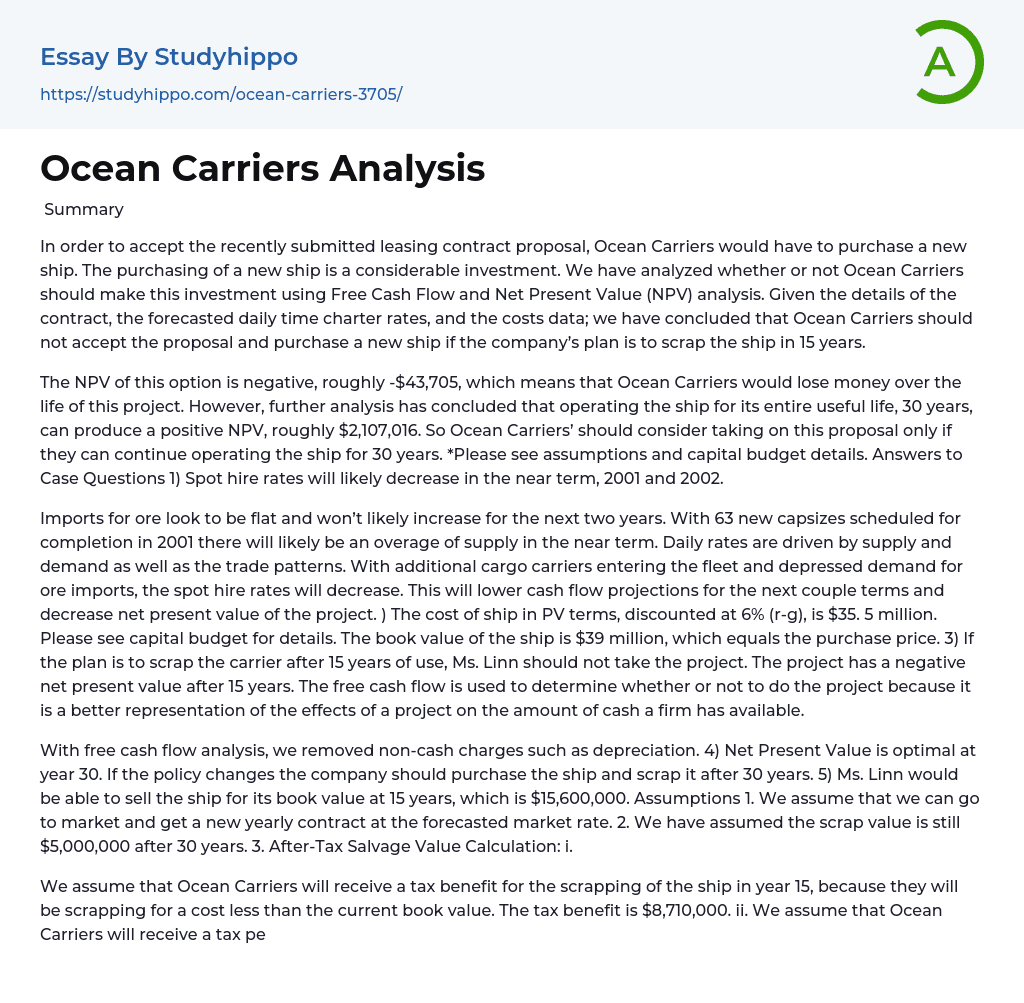Summary
In order to accept the recently submitted leasing contract proposal, Ocean Carriers would have to purchase a new ship. The purchasing of a new ship is a considerable investment. We have analyzed whether or not Ocean Carriers should make this investment using Free Cash Flow and Net Present Value (NPV) analysis. Given the details of the contract, the forecasted daily time charter rates, and the costs data; we have concluded that Ocean Carriers should not accept the proposal and purchase a new ship if the company’s plan is to scrap the ship in 15 years.
The NPV of this option is negative, roughly -$43,705, which means that Ocean Carriers would lose money over the life of this project. However, further analysis has concluded that operating the ship for its entire useful life, 30 years, can prod
...uce a positive NPV, roughly $2,107,016. So Ocean Carriers’ should consider taking on this proposal only if they can continue operating the ship for 30 years. *Please see assumptions and capital budget details. Answers to Case Questions 1) Spot hire rates will likely decrease in the near term, 2001 and 2002.
Imports for ore look to be flat and won’t likely increase for the next two years. With 63 new capsizes scheduled for completion in 2001 there will likely be an overage of supply in the near term. Daily rates are driven by supply and demand as well as the trade patterns. With additional cargo carriers entering the fleet and depressed demand for ore imports, the spot hire rates will decrease. This will lower cash flow projections for the next couple terms and decrease net present value of the project. ) The
cost of ship in PV terms, discounted at 6% (r-g), is $35. 5 million. Please see capital budget for details. The book value of the ship is $39 million, which equals the purchase price. 3) If the plan is to scrap the carrier after 15 years of use, Ms. Linn should not take the project. The project has a negative net present value after 15 years. The free cash flow is used to determine whether or not to do the project because it is a better representation of the effects of a project on the amount of cash a firm has available.
With free cash flow analysis, we removed non-cash charges such as depreciation. 4) Net Present Value is optimal at year 30. If the policy changes the company should purchase the ship and scrap it after 30 years. 5) Ms. Linn would be able to sell the ship for its book value at 15 years, which is $15,600,000. Assumptions 1. We assume that we can go to market and get a new yearly contract at the forecasted market rate. 2. We have assumed the scrap value is still $5,000,000 after 30 years. 3. After-Tax Salvage Value Calculation: i.
We assume that Ocean Carriers will receive a tax benefit for the scrapping of the ship in year 15, because they will be scrapping for a cost less than the current book value. The tax benefit is $8,710,000. ii. We assume that Ocean Carriers will receive a tax penalty for the scrapping of the ship in year 30, because the ship would have been fully depreciated by year 25. At year 30 the book value will be $0.
The tax penalty at a 35% tax rate is $1,750,000. 4. We assume that the number of operating days remains 349 from years 16 to 30. 5. We assume that the expected daily hire rate will remain constant from year 2027 to 2032.
- Money essays
- Financial Accounting essays
- Market Segmentation essays
- Supply And Demand essays
- Purchasing essays
- Forecasting essays
- Legacy essays
- Bank essays
- Corporate Finance essays
- Financial News essays
- Financial Ratios essays
- Financial Services essays
- Free Market essays
- Shareholder essays
- Personal finance essays
- Equity essays
- Financial Crisis essays
- Banking essays
- Credit Card essays
- Currency essays
- Debt essays
- Gold essays
- Loan essays
- Enron Scandal essays
- Foreign Exchange Market essays
- Investment essays
- Venture Capital essays
- Stock Market essays
- Retirement essays
- Donation essays
- Net Present Value essays
- Income Statement essays
- Commercial Bank essays
- Debit Card essays
- Deposit Account essays
- Subprime Lending essays
- Perfect Competition essays
- Underwriting essays
- Synergy essays
- Valuation essays
- Investing essays
- Asset essays
- Depreciation essays
- Discounted Cash Flow essays
- Foreign Direct Investment essays
- Funds essays
- Internal Rate Of Return essays
- Revenue essays
- Day Trading essays
- Futures Trading essays




